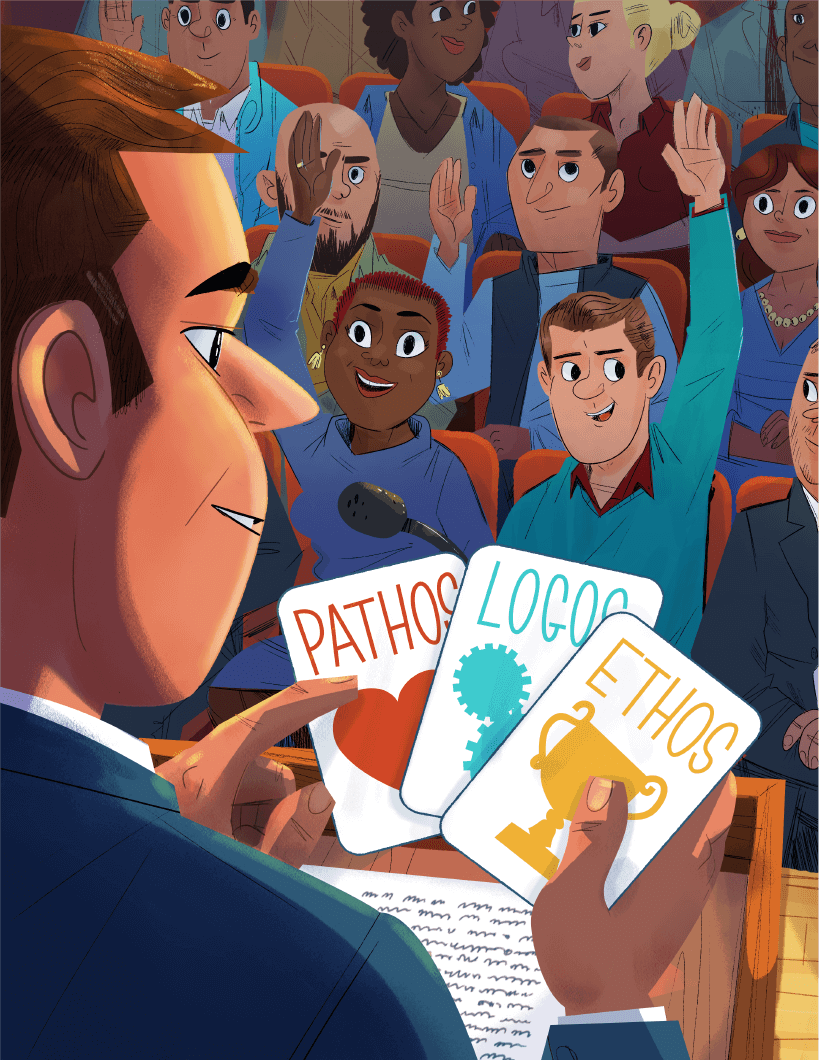
Persuasive speaking has always been among the most challenging of rhetorical exercises. It’s downright difficult to convince an audience to believe something or to take a particular action.
Why else do you think speakers were getting tips on this task as far back as the fourth century B.C.? That’s when Aristotle himself wrote Rhetoric, a treatise that outlines the foundational tenets of persuasive speech. The famed Greek philosopher focused on three ways an orator can appeal to an audience: ethos, pathos and logos. In short, ethos emphasizes the speaker’s credibility, pathos appeals to emotion and logos refers to reasoning—specifically, the structure and content of an argument.
The ancient ideas have stood the test of time. As Toastmasters teaches, you have to know your audience, and Aristotle’s ideas reflect that principle. Jeanine Turner, associate professor of communication, culture and technology at Georgetown University in Washington, D.C., says Aristotle taught the importance of adapting one’s messages to different groups. For Aristotle, “it was not about creating the slickest thing, but targeting your audience specifically and the ethos, pathos or logos that resonates with them,” she says. “It’s always about the audience.”
You need to assess your audience’s specific needs and tailor your speech to meet those needs. “The mistake of a novice persuader is saying what you want to say rather than what the audience needs to hear,” says Clay Warren, another Washington, D.C. university professor.
Once you know your audience, decide how to best incorporate and prioritize the three modes of persuasion to appeal to particular listeners. The “Persuasive Speaking” project in Pathways, Toastmasters’ new education program, offers valuable tips. (The project is in Level 3 of the Presentation Mastery path in Pathways.)
- Ethics (Ethos): Credibility is particularly important in getting the audience to trust you. Make sure to reference your expertise and work on this topic and include examples of personal experiences.
- Logic (Logos): In short, your argument has to make sense. Explain, in clear and concise terms, why audience members need to change their opinion or behavior. Boost your argument with comprehensive research.
- Emotion (Pathos): Evoking emotions in listeners, such as happiness or empathy, in relation to your topic is a powerful tool. Using storytelling to make your points is particularly effective.
Talk to Your Audience
When you give a persuasive speech, it’s important to prevent a disconnect between what you say and what the audience needs to hear. One way to do that is to research and ask questions ahead of time. If possible, talk to audience members beforehand in conversational settings. Too often, “speakers come with a sales pitch,” says Kim Fredrich, a U.S. consultant originally from Canada who conducts sales training for non-salespeople.
She recommends interacting with audience members by “taking the temperature of the room. Ask for names and why they are there.” Observing nonverbal cues, gauging opinions with a raise of hands or electronic polling devices, and asking for feedback, are other ways to glean useful information.
Information from listeners may change the speaker’s goal. “The best questions [to ask audience members] are ones you are curious about because you are truly open to changing your narrative based on what they say,” says professor Turner. Too often, she notes, speakers aren’t truly listening, but rather, asking questions to “trap listeners into agreeing with us.”
Turner says it’s also important to remember that audiences are not homogenous. Even when audience members share demographic characteristics or a cultural background, their opinions and preferences can vary widely and may be influenced by geographic region, age, learning style and many other factors.
If you want to give a powerful persuasive speech, she says, don’t make broad assumptions about who you are talking to. Listen and learn. Audience-centered communication is about truly understanding audience members.
Emotions and Reason
Warren, who has taught university courses in persuasion for more than 30 years—currently at George Washington University—says emotion has to support the rational or it will be hard to persuade anyone of anything. He isn’t advocating that persuasive speakers “kick out logos”; instead, he wants speakers to understand how logic fits into the overall persuasive picture.
“The mistake of a novice persuader is saying what you want to say rather than what the audience needs to hear.”
—CLAY WARRENPersuasive speakers who rely heavily on logos have a limited ability to foster long-term persuasive change, says Warren. “Facts go through your brain like water through a sieve. But a story creates an emotional connection. If you get the emotion, you will remember. It is harder to attach an emotion to a number.”
“Heartfelt speeches should be well organized, crafted and rehearsed, just like analytical ones.”
—DAVID HENDERSON, 2010 TOASTMASTERS WORLD CHAMPION OF PUBLIC SPEAKINGAs an example, he points out that many people can’t remember the date on which they got married, yet they can recount specific details when telling a story about their wedding day.
David Henderson won the 2010 Toastmasters World Championship of Public Speaking with an emotional speech about coping with loss. At the heart of the presentation was his story about losing a cherished childhood friend. For him, pathos is the most important part of persuasive speech, and storytelling is the key to pathos. Stories, he says, resonate with the deeply held values that motivate our thoughts and actions.
“To persuade people, you need to find something they already identify with and tap into it. The best way to do that in a non-confrontational way is by telling a story,” says Henderson, who also uses his persuasive-speaking skills in the courtroom: He is a civil rights attorney in Dallas, Texas.
Henderson is quick to add that logos and pathos are not mutually exclusive in communication. “Heartfelt speeches should be well organized, crafted and rehearsed, just like analytical ones.”
A final tip: To be convincing, you also need to be flexible, whether you’re delivering a persuasive speech or proposing a new work project, says renowned communication coach Nick Morgan.
“You can’t control everything in the moment. You need to have rehearsed so well that you can adjust on the fly if necessary,” he wrote in a post about persuasive speaking on his blog, Public Words. “It’s important as part of your persuasive arsenal that you always appear under control, poised and ready for anything.”
Christine Clapp, DTM is the founder and president of Spoken with Authority, a presentation skills consultancy that elevates the presence and expands the influence of subject-matter experts, leaders, and emerging leaders. She is the co-author of three books, most recently Presenting Now: A Guide to Public Speaking and Leadership Communication Online, in Person, and Beyond.



 Previous
Previous
 Beware the Logical Fallacy
Beware the Logical Fallacy
 Previous Article
Previous Article


